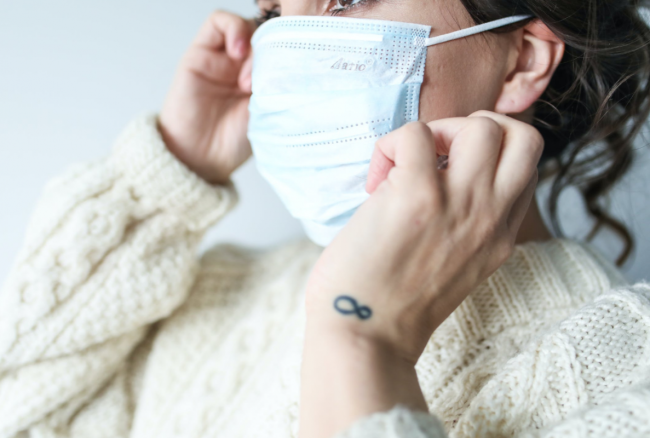You have /5 articles left.
Sign up for a free account or log in.

Pexels.com
COVID-19-related medical research is booming for reasons obvious and urgent. Perhaps less predictably, social science research is having a moment, too. Many social scientists see disasters as invaluable lenses through which to study the good, the bad and the ugly of human societies. And the coronavirus pandemic is one hell of a lens, they say.
“It’s during moments of crisis when oftentimes we can learn most about the social order,” said sociologist Lori Peek, director of the Natural Hazards Center at the University of Colorado at Boulder. “Think about what’s happening right now with the massive inequalities that are emerging in this pandemic and the social and economic fault lines that are opening wide.”
No Area of Life Untouched
Medical research matters, of course, Peek said -- most of all that which seeks to produce a vaccine. But who will trust the science and agree to take that eventual vaccine, under which conditions? That, among other areas, is where social scientists can help, she said.
Peek loves disaster research because it’s at once “fundamental social science” and “unapologetically applied,” with clear public health and policy implications.
“The social science being done right now is important. It's a matter of life and death in many cases.”
Alice Fothergill, professor of sociology and a disaster researcher at the University of Vermont, agreed that “this is a pretty applied field. There really is this commitment to understanding what’s going on so that we can reduce suffering in future disasters, but we’re also making contributions to theory.”
Beyond vaccines and public health messaging, social science questions about the coronavirus include how it’s affecting people differently by age and socioeconomic status, and what lasting impacts those differences will have. Fothergill, for instance, is working on a study that asks two particularly vulnerable groups, children and seniors, to keep journals and even map out their daily lives during social isolation.
“We’re trying to be really innovative in thinking about methods,” Fothergill said, noting that subjects in disaster research sometimes experience fatigue or stress -- as individuals or as communities -- from being studied. “The journaling is centered with them. They have the agency; they’re the main actors in this. We’re not swooping in and doing interviews and then swooping back out.”
Peek cut her disaster research teeth in New York City post-Sept. 11, when disaster research was still emerging as a subfield, and later co-wrote with Fothergill a book about children and Hurricane Katrina. This pandemic is already different from everything else she’s seen in that it’s “touched almost every corner of our social lives and world.”
Where the Interest Is
Because of that, she said, “social and behavioral scientists are mobilizing to study the enormous, varied impact of COVID-19.”
The National Science Foundation, National Institutes of Health and other funding sources have recognized the importance of COVID-19-related social science research with millions of dollars in grants already. The NIH, for example, is funding emergency research on topics including the effects and mechanisms of social connectedness, connection and isolation across the life span. Among other work, the NSF’s Division of Social and Economic Sciences is supporting a study on risk perception, media use, stress and protective behaviors within the U.S. population, via a $200,000 Rapid Response Research grant.
Social science journal editors are seeing a related bump in submissions. The American Psychological Association said that submissions for its publications were up 15 times more than the expected growth rate in April, though not all those papers were related to the coronavirus. The association also published a COVID-19-related stress survey, which found that stress levels right now are significantly higher for parents than nonparents (go figure).
As to why a pandemic is an important time to do psychological research, Kim Mills, spokesperson for the association, said that what’s happening “to our world right now is highly unusual and is clearly having psychological impacts. These factors alone would certainly interest researchers.”
Philip Cohen, professor of sociology at the University of Maryland at College Park and a founder of the social sciences research preprint website SocArXiv, said that in the six months leading up to March, SocArXiv averaged 32 uploaded papers per week. Since April, it’s been averaging 55 papers a week, its highest rate ever. More than 90 papers are about COVID-19. Some are clearly in process, but others offer intensive insight into such topics as political attitudes toward the crisis in Spain, whether attitudes toward government improve during or following lockdowns (this study says they do), and how many European parents are rethinking having children as a result of the pandemic. Cohen’s own contribution is a paper on how the epidemic spread in rural U.S. counties -- through prisons, meatpacking plants and nursing homes.
Echoing fellow social scientists, Cohen -- who is not full-time disaster researcher -- said that crises “have a way of revealing the underlying dynamics in a society. The government, or the people, can only respond to an emergency using the tools they have, and you can see the strengths and gaps in stark relief.”
Through his own rural transmission tracking, Cohen said he found evidence of “degraded health systems, underfunded local health departments, understaffed local newspapers and communities heavily dependent on major institutions,” such as prisons and pork plants.
“And of course our lack of universal health care and our grotesquely ineffective federal response reveal fundamental weaknesses with the status quo before the epidemic,” he added.
If disasters are political, they’re also personal. Both phenomena attract public attention. To that point, Cohen said “most social scientists want our work to be relevant, that matters. And we care about the problems we see in our daily lives, the most important problems in society.”
Inequality Concerns and ‘Sociological Imagination’
Through its National Science Foundation-funded Converge project, Peek’s center started a global research registry, in part to connect academics interested in similar topics. Already Converge has offered small grants to over 80 COVID-19 social science research groups. Topics include food insecurity, readying populations for a vaccine, public health risk-communication strategies, mental health, shifting public opinions and behaviors, civil liberties and social control, and economic recovery.
Jon Zelner, a social epidemiologist and assistant professor of epidemiology at the University of Michigan, is working on a Converge-affiliated study about how mass incarceration and segregation impact disparities in COVID-19’s spread. He said he couldn’t give details about the work right now, as it’s sensitive, but called it “a good example of where the epidemiological and sociological worldviews come together.”
Zelner said prior work by some of his colleagues looked at transmission of methicillin-resistant staphylococcus aureus (MRSA) skin and soft tissue infections in urban jails. Hinting somewhat at the questions underpinning his coronavirus research, he said the “received wisdom for a long time had been that jails are hotbeds of transmission for infections like MRSA.” In reality, however, “a strikingly high proportion of individuals” had MRSA before they got to prison.
The the finding “flips” the questions about transmission around, Zelner said. "Are folks coming in colonized because of infection risks, driven by social precarity, in the community, or because individuals who are in jail have likely been there before, due to policies that encourage mass incarceration?"
There may still be a lot of transmission going on in jail, he said, "but it also shows we can't just draw a neat box around this institution that is in fact so porous and pretend that all of the risk comes from there and not elsewhere."
Zelner’s corner of epidemiology runs on “sociological imagination,” he added.
In addition to the Converge project, Zelner and colleagues also are working with the Michigan Department of Health and Human Services to map COVID-19 risk statewide.
“African-Americans in Michigan have clearly been impacted the hardest by COVID-19 in this state,” he said. Yet Zelner’s “confident that the scale of this disparity is even wider and more appalling than the official data suggest.”
Here, he said, “our work is really about trying to provide the best evidence we can to characterize these disparities, in the hope of shining a bright light on them and working with government and community partners to help if we can.”
Risk Assessment and New Research Priorities
Plamen Nikolov, an assistant professor of economics at the State University of New York at Binghamton, is working on a study with his own colleagues on the role of intertemporal biases in influencing individuals’ demand for social distancing. (The project received funding SUNY’s Research Seed Grant Program.)
Collecting data through online platforms and phone surveys, Nikolov’s group hopes to shed light on how people “invest,” or don’t, in their and others’ future health via mask wearing and social distancing measures, and the various cognitive biases, risk perceptions and decision-making processes involved.
From an economics standpoint, “studying individual decisions in the context of a massive epidemic will illuminate economic theory on how people assess and internalize risk and how they decide to invest in their health,” Nikolov said.
From a public health perspective, he added, “and in the absence of any viable vaccine or treatment, the only currently available tool is prevention. And prevention can only happen with a change to individual behaviors, which is what we economists can study with the power of incentives and what kinds of incentives people respond to.”
Most importantly, Nikolov said the project can inform current and future public policy -- namely what factors influence the adoption of social distancing.
While some social scientists have devoted their lives to studying disasters, others have been called to study the coronavirus crisis in particular, due to its singular nature and multitentacled hold on society.
Peek estimated that COVID-19 will be the most studied crisis, certainly of her lifetime. She lauded the many researchers, both career-long and situational, who are “bringing their talents to bear on this disaster.”
Cohen said it’s “not surprising” but still “amazing to watch our priorities change when something this urgent sweeps across the globe.” He has some other research ideas he expect he’ll “never get to now, because they just aren't as important anymore. But we'll see.”





